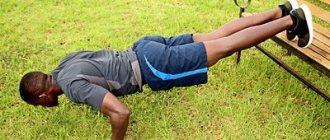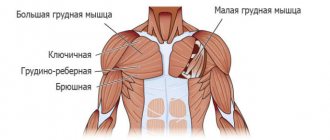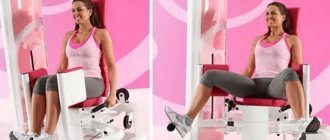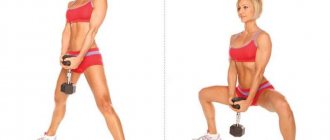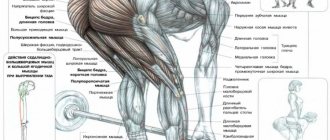- December 18, 2018
- Workouts in the gym
- Nikita Novikov
How long does it take to pump up your pectoral muscles? What are the best exercises for chest training? How to pump up your pectoral muscles at home? Is it possible to pump up your pectoral muscles with push-ups? These questions interest many novice athletes. In the publication you can find answers to your questions. To find out how long it takes to pump up your pectoral muscles, we recommend reading this article to the very end. This way you won’t miss anything important and will receive a lot of useful recommendations.
Anatomy
Exercise and frequency of training is, of course, a very important topic, but first it would not hurt to understand the anatomy of the muscle group discussed in the article.
The chest is divided into two muscles:
- Pectoralis major muscle. This is the name given to the fan-shaped muscle, which is located in front of the chest. The pectoralis major muscle begins on the pectoral bone in the center of the chest and attaches to the humerus near the shoulder joint. Its main function is to flex the humerus toward the chest.
- Pectoralis minor muscle. This muscle is located under the pectoralis major muscle. It begins approximately in the middle of the chest and is attached to the coracoid process of the scapula. The main function of this muscle is to move the shoulder forward.
The serratus anterior is located below the level of the pectoralis major and minor muscles.
In addition, the pectoral muscles can be divided into three bundles: upper, middle and lower.
Well, we've sorted out the theory, now let's move on to practice. Let's start by discussing the most popular chest exercises in the gym.
Horizontal barbell press
The bench press is a basic exercise that, in addition to the pectoral muscles, actively works the triceps and anterior deltoids. It is performed at the beginning of training, when the athlete is still full of strength and energy.
Technique:
- Lie down on a horizontal bench so that the bar is at eye level. Grab the barbell with a wide grip. Remove the projectile from the racks (by yourself or with the help of a partner).
- While inhaling, slowly lower the barbell down. The bar should touch the middle or lower chest.
- As you exhale, press the barbell up with a powerful movement.
- Repeat the movement as many times as necessary.
What exercises should be used to train the chest muscles?
Use only basic exercises; surely some readers need to explain what a basic exercise is and why it is necessary to do it?
Basic exercises are movements in which at least two joints are involved, the main purpose of which is to develop the absolute strength and muscle mass of the athlete. Why is doing basic exercises so much more important than isolating exercises?
The load received from multi-joint exercises is natural for the musculoskeletal system. This makes it possible to fully engage the connection between the brain and muscles, which guarantees peak contraction in the working muscle.
Why is it necessary to specifically train the upper pectoral muscles?
Due to the anatomical attachment, the upper part of the chest is least capable of hypertrophy. Therefore, it is necessary to perform presses on a vertical bench, which specifically work the upper pectoral muscles.
In addition to the above, it is the upper part that visually enlarges the breasts and makes them more powerful. An overdeveloped bottom with an underdeveloped top does not have an impressive appearance. And when an athlete stops training, the chest begins to sag against the backdrop of an overdeveloped bottom, which greatly spoils a person’s appearance.
Program for training impressive chest muscles:
- Incline press at a 30 degree angle, 3 sets of 6-12 reps.
- Dumbbell press on an inclined bench at an angle of 30 degrees, 3 sets of 6-12.
- Dips, 3 sets of 6-12.
In the first years of training, novice athletes can completely eliminate all types of bench presses. To properly work the top of the hoodie, use a bench angle of no more than 30 degrees. Don't make the same mistakes as most people by using a 45-degree angle for bench presses. Thus, you transfer the load to the front deltoids and triceps, which will not allow the chest muscle fibers to reach failure.
Rules for performing the exercise:
- The width of your grip when performing a barbell press should be slightly wider than your shoulders. If you grip too large, peak contraction of the muscle will not occur. If you grab the bar with too narrow a grip, you can increase the amplitude of the movement, but then the pectoral muscles will not stretch in the negative phase. This is why a medium grip is considered ideal.
- Don't use your feet as support; for maximum productivity, place them on a bench. This way, you will press your body against the bench as much as possible and make it more difficult for your pectoral muscles to work.
- When you reach the end of the positive phase of the movement, do not fully extend your arms at the elbow joint. This makes it possible not to include the triceps additionally in the work and keep the entire peak load in the chest. Thus preventing the muscle from relaxing.
How often should you train your chest?
The frequency of training depends on your recovery abilities. If you use pharmacology for recovery, chest training can be performed twice a week, combining light and heavy training.
However, for most gym goers, chest training should be done once a week. In this case, it is better to combine, doing heavy training one week, and light training the second, using 50% of the weights that were used in the heavy phase.
Horizontal Dumbbell Press
The main advantage of dumbbells is that they can be used alternately. In this way, the athlete can not only correct the imbalance, but also force the pectoral muscles to work interconnectedly, bringing the arms together at the top point to achieve maximum contraction.
The technique of performing a dumbbell press is in many ways similar to the technique of a barbell press:
- Grab some dumbbells (by yourself or with the help of a partner) and lie down on a bench. The projectiles should be at the level of your chest.
- As you exhale, press the dumbbells up toward your center. At the top point, do not extend your arms completely to maintain tension in the muscles. Don't let the projectiles touch.
- As you inhale, gently lower the dumbbells to the starting position.
- Do as many repetitions as you need.
Chest program with dumbbells
DAY 1 (bottom)
DAY 2 (top and center)
DAY 1 (bottom)
DAY 1 (bottom)
DAY 2 (top and center)
Reduction of dumbbells on a bench with a negative incline
- 4 sets of 12 reps
- Body part: Chest Equipment: Dumbbells
Pullover with dumbbell
- 4 sets of 12 reps
- Body part: Chest Equipment: Dumbbells
Incline dumbbell press upside down
- 4 sets of 12 reps
- Body part: Chest Equipment: Dumbbells
Dumbbell Bench Press
- 3 sets of 10 reps
- Body part: Chest Equipment: Dumbbells
Incline Dumbbell Press with Neutral Grip
- 3 sets of 10 reps
- Body part: Chest Equipment: Dumbbells
Lifting hands with dumbbells while lying down
- 3 sets of 10 reps
- Body part: Chest Equipment: Dumbbells
Reduction of dumbbells on a bench with a negative incline
- 3 sets of 10 reps
- Body part: Chest Equipment: Dumbbells
Dumbbell abductions lying down
- 3 sets of 10 reps
- Body part: Chest Equipment: Dumbbells
Finish off your workout with a series of stretches that cover your entire body and target your shoulders and chest muscles to ensure that your chest-pumping workout produces really good results.
Tips : The exercises can be swapped from time to time and the workout can begin not with the dumbbell press, but with the hands together. Pullover can be done not only with dumbbells, but also in a block or in a simulator, if there is one in the gym.
Lifehack . For home workouts with dumbbells, we recommend purchasing a Sport Elit press and press bench, which has a straight and negative inclination angle. It is a universal exercise machine, as it can be used to train the abdominal muscles at an angle or as a horizontal surface for exercises with dumbbells.
While working out on this simulator, you can lift your legs or torso, work with your abdominal muscles, do various lifts with dumbbells, and train your long back muscles.
Lifting with dumbbells lying down
Flying with dumbbells in a lying position is aimed at isolated chest work. It is usually performed at the end of the workout. The main advantage of the fly is that it puts a shock load on the chest and excludes the triceps and other third-party muscles from the work as much as possible.
Technique:
- Lie on the floor (it is advisable to lay a special mat), pick up dumbbells and lift them in front of you.
- As you inhale, smoothly spread your arms until your elbows touch the floor. Your arms should be slightly bent at the elbow joints. Don't bend them too much so that the pinch does not automatically turn into a dumbbell press.
- As you exhale, bring your arms together in front of you.
- Do the required number of repetitions.
Exercises with dumbbells for chest muscles
You've probably noticed that most bodybuilders' attention is focused on the effective bench press. Although the bench press is one of the most common exercises in strength training, it is debatable whether it is considered the best movement for the chest. Instead of the classic bench press, it is better to use a varied load on the chest muscles, targeting different parts of it.
The dumbbell bench press additionally engages the core stabilizer muscles and loads the arms more intensely.
Dumbbell Bench Press
Make sure the dumbbells are at the sides of your chest, your shoulders and forearms are bent at right angles, and you have full control of the exercise. At the extreme point of the movement, the arms should be slightly bent at the elbows.
It is better to increase the load without cheating, since it reduces the effect of the workout. Tighten your muscles and then lower the weight half as fast as you lifted it. Pause at the bottom of the lift before quickly lifting the weight.
Additionally, it is advisable to include in the complex a variety of dumbbell presses lying on an inclined bench upside down and dumbbell presses lying on an inclined bench. These exercises will create additional impact on the upper and lower chest.
Incline Dumbbell Press
Incline dumbbell press upside down
The best additional exercise for the chest is rightfully the lying dumbbell fly, in slang “fly” or dumbbell fly. Due to the different angles of the bench, this exercise can pump up all areas of the pectoral muscles. By working even with light weights after the main series, you will quickly notice progress and new feelings of strength.
Reduction of hands with dumbbells while lying down (“Fly”). This exercise is also important in pumping up the chest and can be performed on both a horizontal and an inclined bench.
Dumbbell curls lying on an incline bench
Correctly performed technique allows you to simultaneously load the chest and stretch it in the negative phase of the exercise.
The arms should move in a wide arc until the pectoral muscles are fully stretched, but not below shoulder level, so as not to injure the front part of the shoulder.
As in the previous version of the movement, you can perform dumbbell flyes either lying at an angle of 30-45 degrees or upside down.
Lifting hands with dumbbells while lying down
Pullover. This exercise is also an excellent final movement for the main part of the workout due to its characteristics similar to the fly.
Pullover with dumbbell
Your arms should be bent at the elbows throughout the exercise and move in a wide arc until the pectoral muscles are fully stretched, but not below shoulder level, so as not to injure the front part of the deltoids. Return to the starting position along the same path.
Bringing hands together in crossover
Another exercise aimed at isolated chest work. This is done as follows:
- Take the two D-shaped handles located on the top of the crossover and stand between the posts of the machine. To avoid stress on your joints, bend your elbows slightly. Place one foot forward and spread your arms wide.
- As you exhale, lower your arms forward in an arcing motion to waist level.
- As you inhale, return your arms to the starting position.
- Complete the number of repetitions you need.
Smith Machine Bench Press
This exercise is well suited for people who, for one reason or another, cannot perform the classic bench press. In addition, it can be performed at the end of a workout as a “finishing” exercise for the chest.
The technique of performing a bench press in a Smith machine is practically no different from the classic bench press in a horizontal position. The only difference is that, firstly, in Smith you press along a clearly defined trajectory, and secondly, in the initial position the bar is at the level of your chest, and not at eye level.
These are not all exercises for the chest muscles, we just talked about the most popular and effective ones. If we devoted time to absolutely all chest exercises, it would take dozens of sections.
How to pump up lagging bundles of pectoral muscles?
Quite often it happens that an athlete has a well-developed lower chest, but the upper chest is seriously lagging behind. This is due to the fact that when pressing in a horizontal position, the middle and lower bundles of the pectoral muscles receive the main load. How to fix it? It's simple. It will be enough to change the angle of inclination in bench press exercises. The angle should be no more than 30-45 degrees, otherwise the load will be “eaten up” by your deltoids.
A similar scheme can be used if your lower chest lags behind. Only in this case you need to do the exercise upside down with a slope of 20-40 degrees.
Important! If you suffer from high blood pressure, it is not recommended that you perform exercises in this position!
How many times a week should you pump your pectoral muscles to see the first results faster?
We have specifically dedicated a separate section for this issue. How long does it take to pump up your pectoral muscles? We want to say right away that your success in pumping up your breasts depends on a large number of factors. These include genetics (for some people, breasts grow quickly, while for others, on the contrary, slowly), frequency of training, nutrition, correctness of exercises, etc. As practice shows, if you train regularly, eat right, recover properly After training, perform each exercise technically, then the results can be seen already in the first months of training.
How often can you pump your pectoral muscles? Many people mistakenly believe that the more often they exercise their breasts, the faster they will grow. In fact, this is completely wrong. Due to frequent training, the pectoral muscles will not recover in time, which will greatly slow down muscle growth and lead to a drop in strength indicators. Experts agree that one hard workout per week is more than enough. If nature has not endowed you with good genetics for the pectoral muscles, you can add another, easier workout per week.
How long does it take to pump up your pectoral muscles? We've sorted this issue out, let's move on.
An effective and quick way to pump up your pectoral muscles in 1 month at home
On your day off at home, a great option would be to do push-ups every 30 minutes, 80% of your maximum in one set. In 30 minutes, the muscles will have time to restore glycogen, and you will be able to effectively load them next time. With this approach, an increase in volumes is guaranteed.
After 2 weeks, add 1 more basic exercise and perform it for 12-15 repetitions. For example, a dumbbell floor press should be performed every hour. The main thing is to train every other day or two, or when your strength is fully restored. Pay close attention to how you feel and don’t try to overtrain. Eat plenty of protein and calories, at least 3 large meals a day. Try to increase the load every week, this is the key to the growth of your pectoral muscles.
Example training program
The most popular and most effective training system is the three-day split. It looks something like this:
- Monday: chest and triceps workout.
- Tuesday: rest.
- Wednesday: back and biceps workout.
- Thursday: rest.
- Friday: shoulder and leg workout.
You can also train antagonist muscles in one day:
- Monday: chest and biceps workout.
- Tuesday: rest.
- Wednesday: back and triceps workout.
- Thursday: rest.
- Friday: shoulder and leg workout.
Thus, your chest training falls on Monday. An average chest workout looks something like this:
- Incline bench press: 3 sets of 8 reps.
- Dumbbell bench press in a horizontal position: 3 sets of 10 reps.
- Dumbbell flyes upside down (if you don't have pressure problems): 3 sets of 10 reps.
- Crossover curls: 3 sets of 12 reps.
It’s worth saying right away that this is just an example of chest training. It may work for some people, but not for others. There is simply no universal program that would suit absolutely everyone.
How to pump up your chest with dumbbells - basic training
Dumbbell Bench Press
- 4 sets of 12 reps
- Body part: Chest Equipment: Dumbbells
Incline Dumbbell Press
- 4 sets of 12 reps
- Body part: Chest Equipment: Dumbbells
Lifting hands with dumbbells while lying down
- 4 sets of 12 reps
- Body part: Chest Equipment: Dumbbells
Pullover with dumbbell
- 4 sets of 12 reps
- Body part: Chest Equipment: Dumbbells
Add to Calendar * Add to My Workouts * Print Workout
* — The service is in beta testing
It is recommended to perform this chest training program 2 times a week, dividing the workouts by chest sections: separately for the top, separately for the middle and bottom of the pectoral muscles. The upper part of the chest muscles is more difficult to develop, so it is important to pay more attention to it and train it on a separate day. For example, you devote Monday to the top and center of the chest, and Thursday to the lower and middle parts. The training duration will be no more than 40 minutes.
Now let's move on to an analysis of each exercise and additional training options.
Is it possible to pump up the pectoral muscles at home?
What exercises can you do to pump up your chest muscles if you can’t go to the gym? Is it even possible to do this without additional equipment? Yes, the pectoral muscles can be pumped up without barbells, dumbbells and exercise machines. The most effective and, most importantly, the most accessible exercise for pumping up the chest is push-ups. They can be called a good alternative to the classic bench press. Just like the bench press, you can change the angle to target a specific area of the pecs.
Technique:
- Take a lying position. The position of the hands should be wide. Hold your body so that it forms a straight line. Place your feet on your toes.
- As you exhale, lower your body down.
- As you inhale, press your body up.
At a certain point, it will become too easy for you to do regular push-ups. When your repetitions exceed 30-50 repetitions (assuming you do them well), you will need to take additional weights (for example, a backpack filled with books) and do push-ups with it. The weight should be such that you can perform 6-12 repetitions per set. In the next section we will post a video that shows how you can pump up your pectoral muscles with push-ups.
Lower pectoral muscle training
Incline Dumbbell Press
- 4 sets of 8-12 reps
- Body part: Chest Equipment: Dumbbells
Dumbbell flyes on a negative incline bench
- 4 sets of 8-12 reps
- Body part: Chest Equipment: Dumbbells
Pullover dumbbells on bench
- 4 sets of 8-12 reps
- Body part: Chest Equipment: Dumbbells
Add to Calendar * Add to My Workouts * Print Workout
* — The service is in beta testing
Train as hard as you can and remember to rest and recover: get at least 8 hours of sleep.
Tips and tricks
Here are some helpful tips to make your workouts more effective and safer:
- Warm up well before each training session. This doesn't just apply to chest training, this applies to all workouts in general;
- During the bench press, use the help of a partner so that he can give you heavy weight and in case of emergency;
- Do each exercise as technically as possible. The effectiveness of these very exercises depends on your technique.
How many times a week should you pump your breasts? We think we have managed to answer this question. We hope that the information provided in this article was useful to you.
